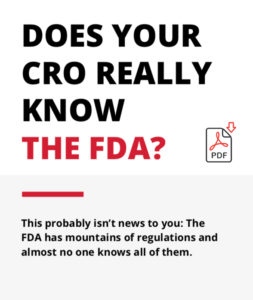Real World Data Part 4: How to Use it Properly
 In order to determine the suitability of Real World Data (RWD) for regulatory decision-making, the FDA will assess the relevance and reliability of the source and its specific elements. Important factors associated with RWD relevance primarily are: 1) sufficient details 2) capability to address specific questions 3) interpretable using informed clinical/scientific judgement. Reliability of RWD is associated with data accrual and data assurance. Data assurance consists of the quality of data element population, adherence, completeness, consistency and program evaluation process.
In order to determine the suitability of Real World Data (RWD) for regulatory decision-making, the FDA will assess the relevance and reliability of the source and its specific elements. Important factors associated with RWD relevance primarily are: 1) sufficient details 2) capability to address specific questions 3) interpretable using informed clinical/scientific judgement. Reliability of RWD is associated with data accrual and data assurance. Data assurance consists of the quality of data element population, adherence, completeness, consistency and program evaluation process.
Specifically, when RWE is intended to be used for purposes of evaluating a regulatory question, the following considerations for RWD should be put in mind:
- In order to use RWD, the device must be sufficiently identified with the level of detail necessary to address the regulatory question. For example, to evaluate a particular device, the Unique Device Identifier (UDI) or serial/model number may be necessary to identify the device within a RWD source that contains data on many similar devices;
- RWD should meet the criteria of relevance and reliability;
- RWD should be presented to FDA according to recognized data standards (i.e. in standardized file formats and data structures, utilizing standardized variables and definitions, etc.) when applicable.
- If RWE is derived from multiple RWD sources, each RWD source will be evaluated individually and together in the aggregate to determine the relevance and reliability of the RWD.
- The methodology used to analyze RWD and assess clinically relevant differences as well as statistical significance should be scientifically robust.
To give some examples, FDA has been using RWD and RWE, derived from the Sentinel System, to eliminate the need for post-market studies on nine potential safety issues involving five products. This makes FDA’s post-market evaluation of safety timelier and more effective.
RWD may potentially be used as some or all of the evidence necessary for understanding medical device performance at different points in the TPLC. Some purposes for which RWD may potentially be used include the following:
- for generating hypotheses to be tested in a prospective clinical study;
- as a historical control, a prior in a Bayesian trial or as one source of data in a hierarchical model or a hybrid data synthesis;
- as a concurrent control group or as a mechanism for collecting data related to a clinical study to support device approval or clearance in a setting where a registry or some other systematic data collection mechanism exists;
- as evidence to identify, demonstrate, or support the clinical validity of a biomarker;
- as evidence to support approval or granting of an Humanitarian Device Exemption, Premarket Approval Application (PMA), or De Novo request;
- as support for a petition for reclassification of a medical device under section 513(e) or (f)(3) of the FD&C Act;
- as evidence for expanding the labeling of a device to include additional indications for use or to update the labeling to include new information on safety and effectiveness
- for public health surveillance efforts. Through ongoing surveillance, signals are at times identified that suggest there may be a safety issue with a medical device. RWE may be used to refine these signals for purposes of informing appropriate corrective actions and communication;
- to conduct post-approval studies that are imposed as a condition of device approval or to potentially preclude the need for post-market surveillance studies ordered under section 522 of the FD&C Act;
- in certain circumstances, for use in generating summary reports of Medical Device Reports (MDRs); and
- to provide post-market data in lieu of some premarket data.
Next Steps:
- Read next blog on Real World Data
- See how Princeton’s services can help you.